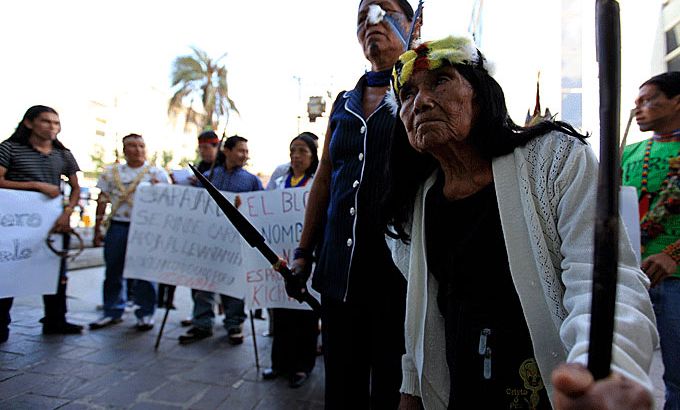
Native Indian tribes facing ‘extinction’?
As demand for natural resources impacts Latin America’s indigenous groups we ask if their interests will ever be on top.
Indigenous groups call it an existential threat.
The push to exploit natural resources is having a huge impact on native Indian communities across Latin America.
Keep reading
list of 4 itemsCanada wildfires spur evacuation orders, warnings: What you need to know
Evacuation orders issued as wildfire grows near Canada’s Alberta oil patch
Energy summit seeks to curb cooking habits that kill millions every year
All too often, they say, their interests and preserving their way of life end up coming second to energy companies and the pursuit of profits.
|
“I saw in one of the documents from Chevron Corp the president of the Texaco unit had ordered all documents relating to oil dumping to be removed from files and destroyed. Oil companies don’t take courts very seriously. They are their own court, their own judge, and they won’t listen to the Ecuadorean government even if it goes along with the courts.“ – Greg Palast, an investigative reporter and author of Vultures’ Picnic |
Serving as the most notorious example for indigenous groups is that of the oil giant, Chevron, which last year was fined an unprecedented $18bn.
The company was found guilty of heavily polluting large parts of Ecuador’s rainforest. But it is fighting the ruling in the international courts, and so far has not paid a single cent of the fine.
And it is not just oil. Mining is also a source of tension for Indian tribes around the region in countries like Bolivia, Peru and Colombia.
In Ecuador, the Kichwa people in the town of Sarayaku are fighting the government whom they accuse of granting drilling rights to an Argentine oil company without their consent.
Responding to the Kichwa’s protests the Ecuadorian government told Al Jazeera in a statement from the office of Washington Pesantez, the attorney-general of Ecuador:
“Ecuador’s defence believes that one must observe a balance between the good of society and the good of one particular group. An indigenous community, while it should be respected and protected, should not impose its will on the entire region.”
|
“In Latin America the people who are on the land don’t own the rights to the subsoil, which essentially means they belong to the government. In the US they do. At the same time huge mining and energy companies find ways of buying those rights. … The end result of oil exploration is bad for indigenous people anywhere in the world.” – Peter Hakim, the former president of the Inter-American Dialogue |
Sarayaku is situated deep in Ecuador’s Amazon jungle. In 1996, the Ecuadorian government gave oil-rich land in Sarayaku to the Argentine company CGC. So far, the Sarayaku protests and the legal action have prevented drilling. In 2003 they took their case to the Inter-American Commission on Human Rights. It has still yet to rule on the dispute.
Among their complaints, they say Ecuadorian troops illegally detained and tortured community leaders at a CGC facility. During the nine-year case, the court ordered CGC to remove a large number of explosives used for seismic testing. But for the most part, the injunction, along with many others, has been ignored.
So, are indigenous groups losing out to government and energy interests in Latin America?
Joining the discussion on Inside Story Americas with presenter Anand Naidoo, who travelled to Sarayaku to find out how the indigenous community is being impacted, are guests: Peter Hakim, the former president of the Inter-American Dialogue; Kevin Koenig, the Ecuador programme coordinator for Amazon Watch; and Greg Palast, an investigative reporter and author of Vultures’ Picnic, a book about the petroleum industry.
|
“Ecuador is a tragic example as shown in the Chevron case where there has been 40 years of systematic drilling and dumping using substandard technologies that have been outlawed and banned in the US in the early 1900s. [Companies like Chevron] basically decide that the people of the rainforest don’t matter.” Kevin Koenig, Amazon Watch Ecuador programme coordinator |
| Sources of tension:
In Peru last year, hundreds of local residents staged lengthy protests in Puno against Canada’s Bear Creek Mining Corporation for the potential environmental impact of mining in the region. Peru has since adopted a new law requiring mining and oil companies to consult indigenous communities before construction. In Colombia, the US-owned Muriel Mining Company built a mine within sacred territory of the Embera people in the Choco and Antioquia departments. The tribe says it was not consulted. In Bolivia, which has a long mining tradition, the potential exploitation of huge lithium deposits in its famous Salt Flats region is also a source of concern for indigenous groups. |